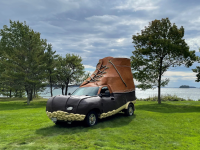Grow It In Maine
The September ground was strewn with fruits like translucent black olives.
“Dogwood!” Deb cried out.
Sure enough, those berries were the same shape that grows on the Cornelian cherry tree after the fluffy yellow April flowers had finished blooming. (From mine, the fruits were like glowing rubies.) I’d tasted those fruits; they were sour. Or were they really not ripe?
My reference books had been scattered, but one had suggested that the berries came from a cousin of my Cornus mas: formally called Cornus sessilis, or blackfruit, or miner’s dogwood. I called my horticulturist friends: no luck. Where had these strange berries grown?
One person suggested that the original plant might have come from another part of the country with some avid plant hunter. Right now, I’ll ask for readers’ help.
Here are some guesses. Correct me if I’m wrong and help me get at the truth.
I learned that blackfruit dogwoods are native to northern California’s Cascade mountain region. Many grow along stream banks. They prefer shade and steady moisture over drought-and-flood conditions.
Maine-and-California Ginnie might have the answer. If she or anyone else has one, please send it, care of this newspaper?
Perhaps I have been mistaken in identifying the shrub or tree. Readers, set me straight!
Your guess is as good as mine – if not better. A reader might have seen a picture of a specimen of this dogwood plant and ordered it to come to Maine, not knowing where it would thrive best – likely not Maine?
If that’s the case, please let me know, for after all ... the name of this column is “Grow It In Maine.”
Besides the white-flowered dogwood tree, cousins include the shade-loving bunchberry ground cover; red-twig dogwood which cheers the winter landscape; and variegated-leaf shrub for foliage interest. Is this a family for all seasons?
Event Date
Address
United States






















